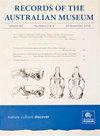文章标题西澳大利亚金伯利地区已灭绝的假吸血蝙蝠一新种(大皮蝠科:大皮蝠)
IF 0.8
4区 生物学
Q4 ZOOLOGY
引用次数: 0
摘要
从西澳大利亚金伯利地区奥斯卡山脉Dingo Gap石灰岩矿床中发现的牙齿、牙齿和上颌碎片中,描述了一种新的假吸血蝙蝠(Megadermatidae)Macroderma handae sp.nov。根据同一样本中的生物相关性,这种材料可能是上新世或更新世早期。P2的缺失表明它比包括M.malugara和M.godthelpi在内的中新世分类群更具起源性,但其相对于M.koppa的系统发育位置尚无法确定。根据M1和M2的大小,它似乎略小于M.gigas和M.koppa。上颌骨开窗程度较低,可以将其与M.gigas区分开来;和所有其他种类的Macroderma相比,M1的原窝形状,加上M2的原锥相对较高,在三角体内面积相应较大。其他收集到的材料,但尚未完全鉴定或描述,包括来自一种防腐动物的几种下犬科动物,以及一种M1-3的齿类动物,代表一种蝙蝠。考虑到在新描述的Macroderma物种的M3上观察到的磨损条纹,我们认为它是小型脊椎动物的捕食者,可能包括洞穴中的翼手目共同居民。该新种是迄今为止在该属中确认的第六个物种,也是上新世以来的第二个物种。本文章由计算机程序翻译,如有差异,请以英文原文为准。
A new species of extinct False Vampire Bat (Megadermatidae: Macroderma) from the Kimberley Region of Western Australia
A new species of False Vampire Bat (Megadermatidae), Macroderma handae sp. nov., is described from dental, dentary and maxillary fragments recovered from limestone deposits at Dingo Gap, Oscar Range, in the Kimberley region of Western Australia. This material is likely to be of Pliocene age, or early Pleistocene, based on biocorrelation within the same sample. The absence of the P2 indicates that it is more derived than Miocene taxa including M. malugara and M. godthelpi, but its phylogenetic position relative to M. koppa could not be determined. It appears to be slightly smaller than M. gigas and M. koppa based on the size of M1 and M2. It can be distinguished from M. gigas by the lesser degree of fenestration in the maxilla; and from all other species of Macroderma by the shape of the protofossa of the M1, plus the M2 protoconid relatively high and of proportionally greater area within the trigonid. Other material collected, but not identified completely or described, includes several lower canines from a species of emballonurid, and a dentary with M1-3 representing a vespertilionid bat. Given the wear striations observed on the M3 of the newly-described Macroderma species, we suggest that it was a predator of small vertebrates, including possibly the chiropteran co-inhabitants of the cave. This new species of Macroderma is the sixth species recognized in the genus so far, and the second from the Pliocene.
求助全文
通过发布文献求助,成功后即可免费获取论文全文。
去求助
来源期刊
CiteScore
0.90
自引率
0.00%
发文量
9
审稿时长
>12 weeks
期刊介绍:
Records of the Australian Museum, volume 62 was published in 2010, volume 63 in 2011. Monographic works of particular significance are published irregularly as Records of the Australian Museum, Supplements (ISSN 0812-7387).

 求助内容:
求助内容: 应助结果提醒方式:
应助结果提醒方式:


